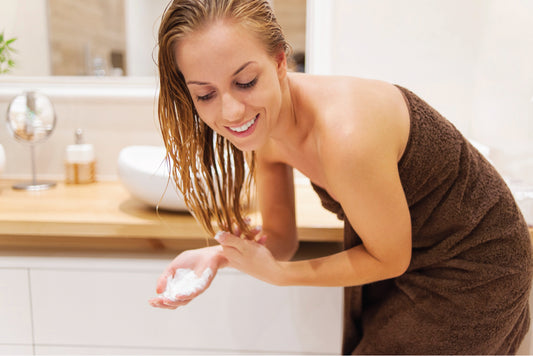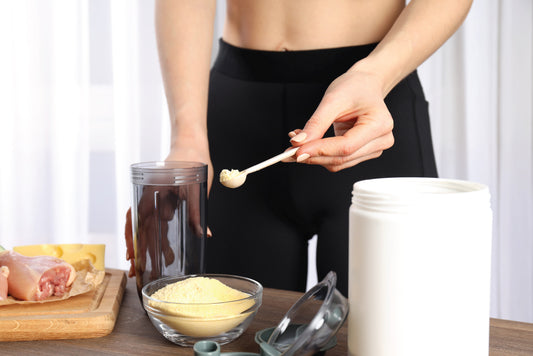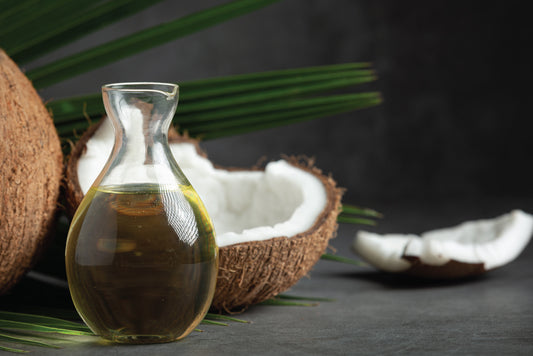Sebum is the natural oil in your skin and scalp, produced in the hair follicles.
If your skin is oily and your scalp is showing it excessively in the form of dandruff and acne, it’s trying to tell you that you need help.
No matter your age or skin texture, keep reading to get some useful tips on how to manage sebum hair.
Let's get started!
Table of Contents
- Scalp Sebum: Everything You Need To Know
- What Scalp Sebum Does To Your Hair?
- Does Scalp Sebum Promote Hair growth?
- Reasons That Causes Sebum On Your Scalp
- How To Control Sebum Production?
- How Can People With Oily Skin Manage Sebum At Home?
- Use Apple Cider Vinegar
- Essential Oils
- DIY Hair Masks
- Final Words
- FAQ#1: Why do I have so much sebum on my scalp?
- FAQ#2: How to exfoliate your scalp?
- FAQ#3: How to detox your scalp?
- FAQ#4: What foods can help you reduce sebum production?
- FAQ#5: What vitamins are good for reducing sebum production?
- FAQ#6: At what age does sebum production start decreasing?
Scalp Sebum: Everything You Need To Know
You might have come across the words scalp sebum in many beauty magazines and blogs. The real question is: What is Scalp Sebum or Sebum hair and how does your skin produce it?
You might be thinking that sebum is what makes your hair look greasy, after every second day since you washed your hair, right?
Well, it depends, it is true sebum makes your hair look oily but on the other hand, you might not know that it is important for healthy hair.
Our body has a great number of sebaceous glands that secretes an oil called sebum. Sebum acts as a natural moisturizer that gives your hair a naturally soft and hydrated look. Learn more about Scalp Sebum research here.
What Scalp Sebum Does To Your Hair?
The biggest confusion among all is, either sebum is good or bad for your hair?
An adequate amount of sebum production on the scalp can help maintain the pH balance of your hair causing your hair strands to be shiny, strong, smooth, and improve hair health.
But what if sebum buildup exceeds too much?
The worst it can do is block the hair follicles and stop the hair growth, leading to hair loss or causing a condition named folliculitis, which damages hair follicles.
Does Scalp Sebum Promote Hair growth?
Don't worry sebum is not all bad. Without it, our hair would get all dry and brittle.
It is important that you manage sebum production so that its moderate amount can protect the natural oils of your hair and improve hair health.
But remember, sebum overproduction will have an opposite effect on your hair growth because an oily scalp will cause the hair to fall even faster.
Reasons That Causes Sebum On Your Scalp
There are several reasons that we come across in our daily routine that produce sebum on the scalp.
These include: Sweat, hair products with moisturizers, and worst of all dead skin cells accumulated on the scalp cause bacteria to grow in your hair follicles.
In other words, maintain your hair hygiene.
Also, your hormonal changes, genetics, and health issues have a huge impact on sebum overproduction.
How To Control Sebum Production?
Consider yourself lucky…
You can manage sebum production in natural ways even if you have naturally excessive oily hair. All you have to do is make some changes to your hair care regimen.
Some of these methods that you can follow are:
- Avoid hot showers
- Do not shampoo daily
- Apply hair conditioner only on hair ends
- Use clean pillowcases
- Avoid hair products containing silicone
How Can People With Oily Skin Manage Sebum At Home?
Once you understand your hair condition, you know it's time to protect your hair from being over-greasy and remove all unwanted toxins released on your skin with natural hair treatment.
Ways to treat your oily scalp at home are:
Use Apple Cider Vinegar
1 part apple cider vinegar and 2 parts water can help maintain the pH of your scalp and reduce oil production on your scalp.
It’s better to have a patch check before using to avoid any skin irritation.
Essential Oils
Tea tree oil is the most beneficial for reducing excessive oils from the skin. Research shows tea tree oil helps get rid of dandruff, greasy hair, and itchiness. Some other oils worth mentioning are: Lavender oil, Rosemary oil, and lemon oil Learn more about research on tea tree oil.
DIY Hair Masks
You should take some time out to put some extra effort into a healthy hair routine. Some homemade hair masks good for healthy hair are:
- Apple with a beer hair mask
- Yogurt hair mask
- Tomato hair mask
- Aloe Vera hair mask
Final Words
Sebum on the scalp and associated scalp problems can be stressful but no worries, as this article will help you know the tips for healthy hair remedies to control sebum production and prevent it from developing into any worse scalp conditions.
FAQ#1: Why do I have so much sebum on my scalp?
Hormonal imbalance is one of the main reasons for sebum overproduction. Other reasons for excessive sebum on the scalp may include consuming unsaturated fats affecting your metabolism and causing metabolic disorders.
FAQ#2: How to exfoliate your scalp?
Scalp exfoliation is a massage you can do yourself either on wet or dry hair. You can use a scrub or a homemade hair mask, apply it to your scalp and massage your scalp with your fingertips in circular motions.
FAQ#3: How to detox your scalp?
Detoxing your scalp means exfoliating your scalp to help you get rid of dead skin cells on your scalp. It also reduces flaky and itchiness and oil buildup. You can detox your skin by massaging or brushing your scalp after applying an exfoliating scrub.
FAQ#4: What foods can help you reduce sebum production?
Foods rich in vitamin A can help reduce the activity of your sebaceous glands. Some foods worth mentioning are green leafy vegetables, mango, eggs, sweet potato, and papaya.
FAQ#5: What vitamins are good for reducing sebum production?
Vitamin A and D are the fat-soluble vitamins that target your sebaceous glands and help maintain oil on your scalp.
FAQ#6: At what age does sebum production start decreasing?
Sebum production starts decreasing at the age of 20 and continues to reduce oil production with age. The areas of the body with the most sebaceous glands are the face, chest, scalp, and upper neck. These areas are likely to get acne in case of sebum overproduction.




